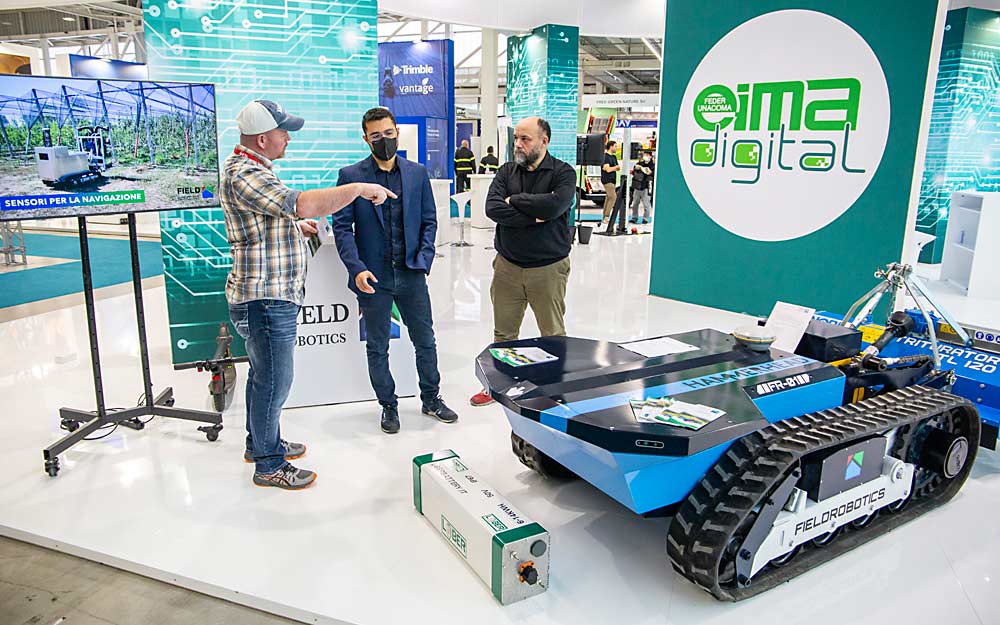
If agricultural equipment trade shows are any indication, Italians care about style.
Tractor vendors hire gourmet chefs for their booths. Cardboard fruit boxes are backlit as if at a technology product launch. Sprayer nozzles fan out symmetrically like jewelry under glass.
“We try to invest more in the appearance,” said Lorenz Seppi, president of Seppi M., an Italian mulcher manufacturer based in Trento, Italy.
There are practical reasons for the showmanship, he said. European agricultural expos often focus on international markets, so the clients are CEOs, dealers and procurement officers, not necessarily farmers themselves, Seppi said. Meanwhile, vendors use social media to spread flashy messages with the image-conscious crowd. The same swagger could be found at shows in Germany or the Netherlands.
But Europeans invest in design, as well as performance, Seppi said. Style also penetrates the machinery itself, designed to produce high-quality fruit in high-density orchards on steep hills in the country that brought us Ferraris.
That mix of form and function, plus Italy’s specialty crop focus, draws growers from the U.S. and around the world to Italian farm equipment and the expos showcasing it. In November, attendees of an International Fruit Tree Association tour explored the equipment on display at Interpoma in Bolzano and EIMA in Bologna.
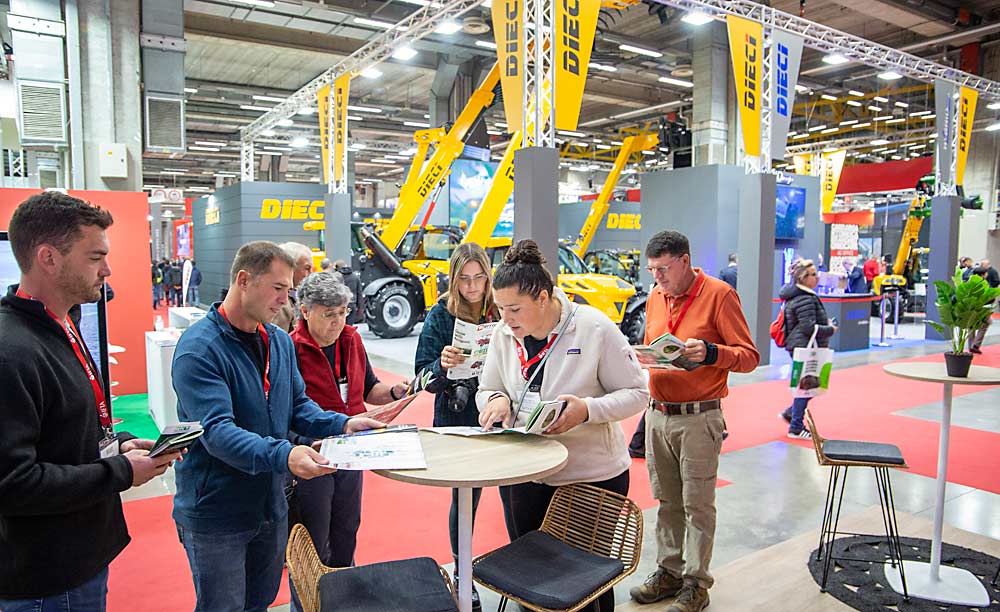
Appearances indeed matter to Italian farmers, said Seppi, who grew up in an apple farming family. Many have only 10 to 15 acres of land, but they can make a decent living and have money to spend on flashy machinery. His company, founded by his grandfather, specializes in flail mowers and mulchers, a category of equipment with a large footprint at both shows.
“If the Italians don’t know what to do in the morning, they start to build a flail mower,” Seppi said with a laugh.
Italian orchardists need more mulching and ground clearing equipment than American growers because they replace blocks more often — an average of every 12 years, he said. With land at such high prices, they want to replant as soon as possible. Stump grinders are a hot item at trade shows, too.
Also due to their small farms, the person buying a tractor is likely to drive it and wants something they like, Seppi said.
That helped sell Pennsylvania grower Steve Frecon, who owns two tractors by Italian manufacturer Antonio Carraro, based in Padua, east of Venice. Frecon estimates he spent three months of his 2022 working life sitting on a tractor and wanted something that felt good.
Hills are a factor, too. Italy has steep terrain, just like Frecon’s farm. Innovators in Europe build platforms that level themselves and tractors with tracks instead of wheels. In YouTube videos of Italian farming, Frecon kept noticing the same little red tractor climbing hills. Zooming in, he spotted the logo and eventually ordered one, then another, from a Pennsylvania dealer.
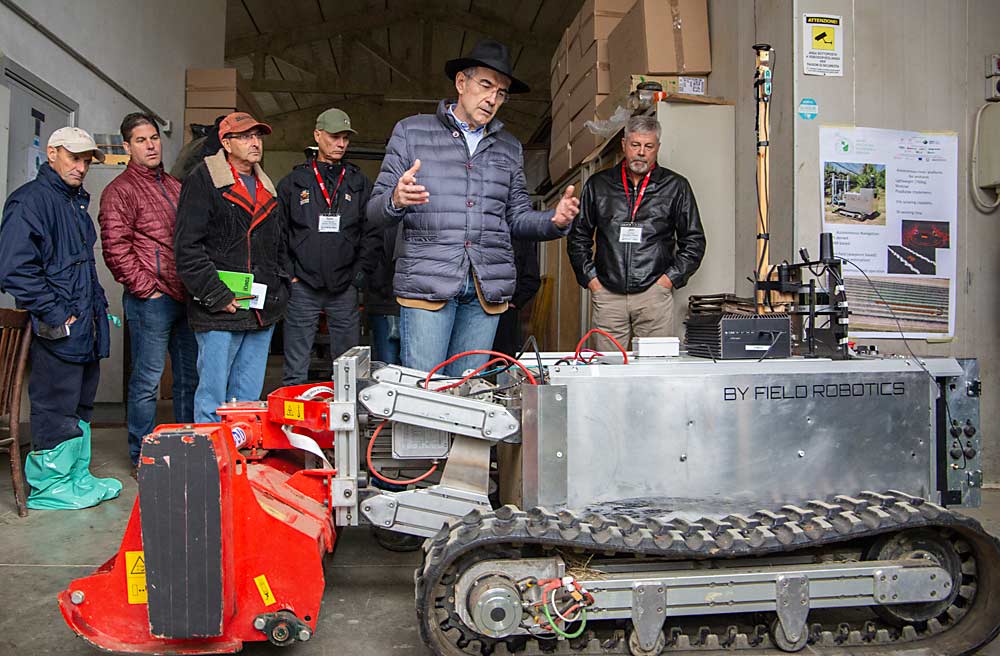
His models do not have tracks; he needs to drive them on roads sometimes. But they do have leveling hydraulics, and the entire control system — seat and dashboard — swivels 180 degrees, so he can drive the tractors backward while facing forward. It’s much easier to back up his Maschio flail mower — another Italian design — on hillsides if he doesn’t have to look over his shoulder.
He doesn’t think Italian equipment is better than American. He owns other brands, too. But he can detect a cultural difference.
“I just feel like the Europeans spend a lot of time thinking about flexibility and getting a lot out of a machine,” he said.
Kevin Oyler, a sales rep at Papé Machinery in Okanogan, Washington, has made 17 trips to Italy during his 25 years at the dealership.
He suspects Italian developers have more incentive to focus on specialty crops while American manufacturers target row crops, because those industries dominate in America. Defoliators and hedgers for orchards and vineyards typically come from Europe, he said.
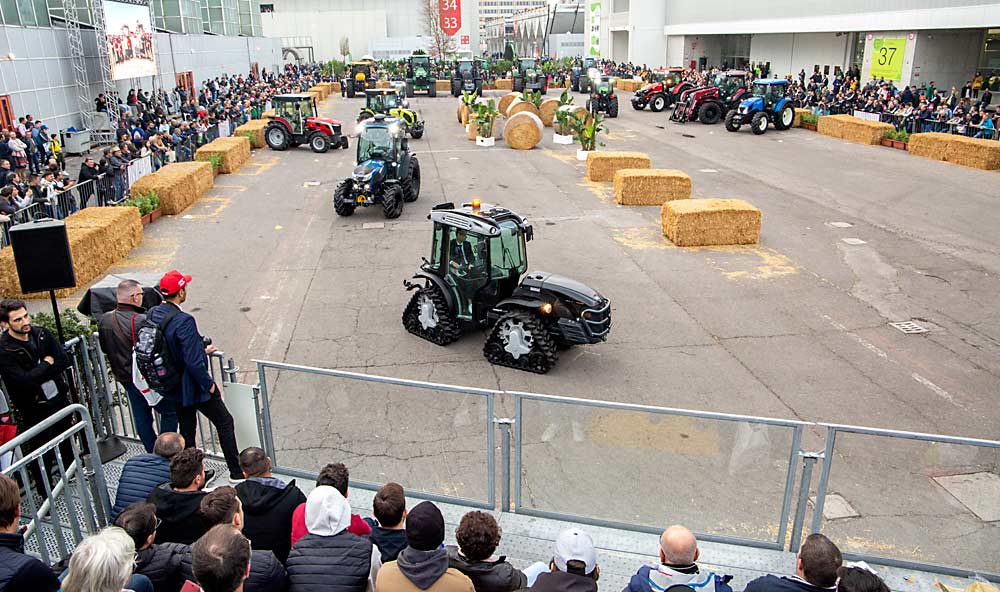
Meanwhile, small-acreage operators spend more time informing designers.
“They’re actually trying to create their own equipment that works for them, and they’re finding it works for a lot of other people, as well,” he said.
And he buys the “style” theory, likening Carraro tractors’ low-profile and curves to a sports car. In fact, Carraro once used consultants from Porsche during a restructuring. For that matter, Italian corporations also have partial ownership in historic U.S. brands International and New Holland.
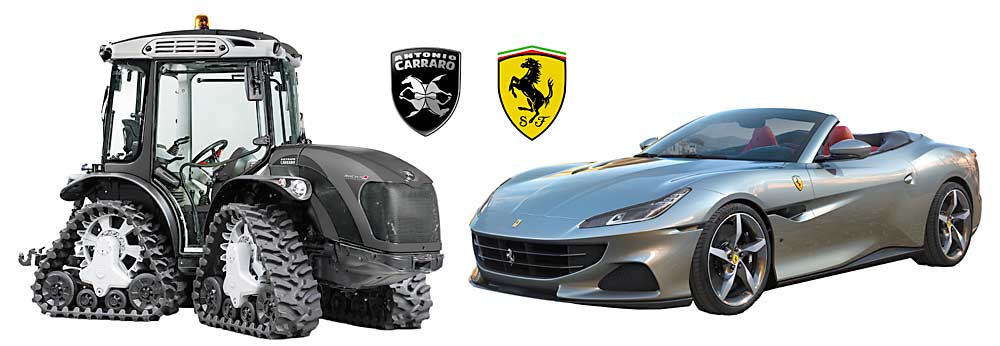
Adding to the mix are agricultural social media influencers.
In Italy, these “farmfluencers” carry celebrity status, Italy’s Seppi said. Trade show crowds ask them for selfies, while social media feeds picture them with tractors, combines and grape harvesters. Naturally, equipment vendors want to team up with them.
For example, Gomiero Farm has earned 300,000 followers on Instagram and been featured on Italy’s Discovery Channel. The family has repped for Antonio Carraro and showed up at trade shows on the company’s behalf.
In the 1990s, farming used to be viewed as a career for old people, Seppi said. Now, youth seem attracted to it.
“They think it’s a cool thing to be,” he said.
—by Ross Courtney
At two flashy trade shows, here’s what caught our eye
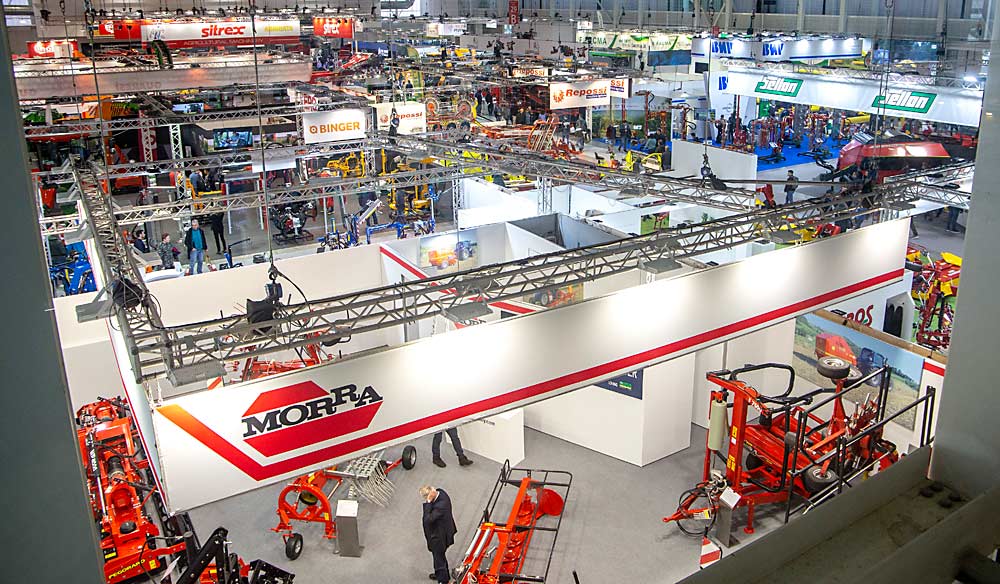
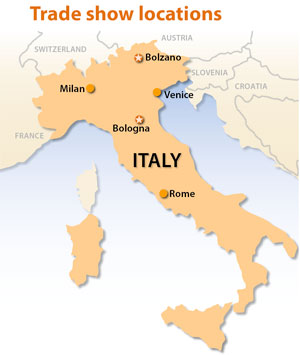
Two agricultural equipment trade shows bookended the International Fruit Tree Association tour of Northern Italy in November.
EIMA, a massive show in Bologna that takes up more than 20 buildings, featured a variety of equipment for vineyards, orchards, row crops and the construction and forestry industries. Interpoma in Bolzano, specifically geared toward apples, carries a smaller footprint but remains a global industry gathering that also features educational presentations and tours.
Both allowed vendors and manufacturers from across the world to showcase innovative, technological and sometimes wacky-looking solutions to common agricultural problems: namely, the rising cost of labor. Here are a few highlights.
—Automated tractors: Several companies showcased them, including units that bear little resemblance to the traditional tractors they aim to replace. A team of engineers and horticultural researchers at the University of Bologna have developed a battery-powered, self-steering rover that is guided by lidar, cameras and artificial intelligence and is so small you could trip over it. To deal with the cramped, steep conditions of Italian orchards and vineyards, it is designed to carry a small spray tank instead of towing a large one. The second-generation prototype, now marketed by the Bologna-based company Field Robotics, was on display at EIMA. Tour-goers also saw the less polished, first-generation version in a shop at the university.
—Platforms: We counted at least a dozen. A few were just simple platforms that carried workers for pruning or thinning, but most featured bin pass-through systems and harvest-assist conveyors that carried individual pieces of fruit to a common bin, allowing pickers — either on the ground or on the risers — to work without bags or buckets. (See “Picking a platform.”)
—Hill climbers: In Italy, especially near Bolzano in the foothills of the Alps, vendors tout the ability of their machinery to work on steep hills. Thus, at the trade shows, equipment was displayed on artificial side slopes and props designed to look like rocks and uneven ground. The Antonio Carraro Mach 4 tractor, with tracks instead of wheels, was a big hit among growers in the IFTA group. EIMA named it Tractor of the Year, allowing company representatives to drive some around outside in a demonstration in front of hundreds of spectators.
—Hand-held tools: At EIMA, Pellenc representatives demonstrated electric pruning shears, olive shaking rakes and vine tying “guns,” all handheld and battery operated. One salesman demonstrated tying on his finger.
—Packing equipment in action: At Interpoma, apple packaging companies brought full — if miniaturized — working equipment and apples to pack. Company executives and pitchmen turned them on and ran fruit over the lines and into boxes. They gathered the apples and repeated for the next customer.
—Innovative packaging. Sustainable boxes and bags of all shapes dotted the exhibition floors at Interpoma. Thin cardboard was a popular choice, but biodegradable, cellulose-based netting stretched over fruit in some displays.
—Varieties: A sizeable chunk of real estate at Interpoma was devoted to varieties. European consumers are traditional in their produce tastes, but those in the industry are constantly on the lookout for new brands, and some production companies have their own breeding programs. Organizers also staged what they called the “Variety Garden,” a collection of 60-some global brands displayed in glass cases and arrayed in the shape of a giant apple on the floor of the main lobby.
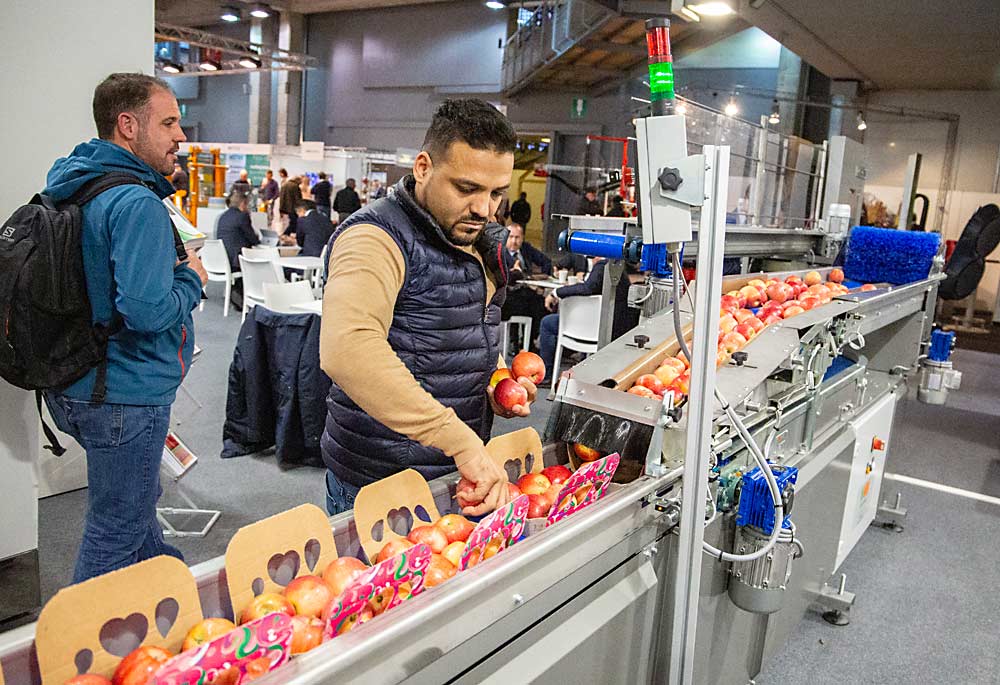
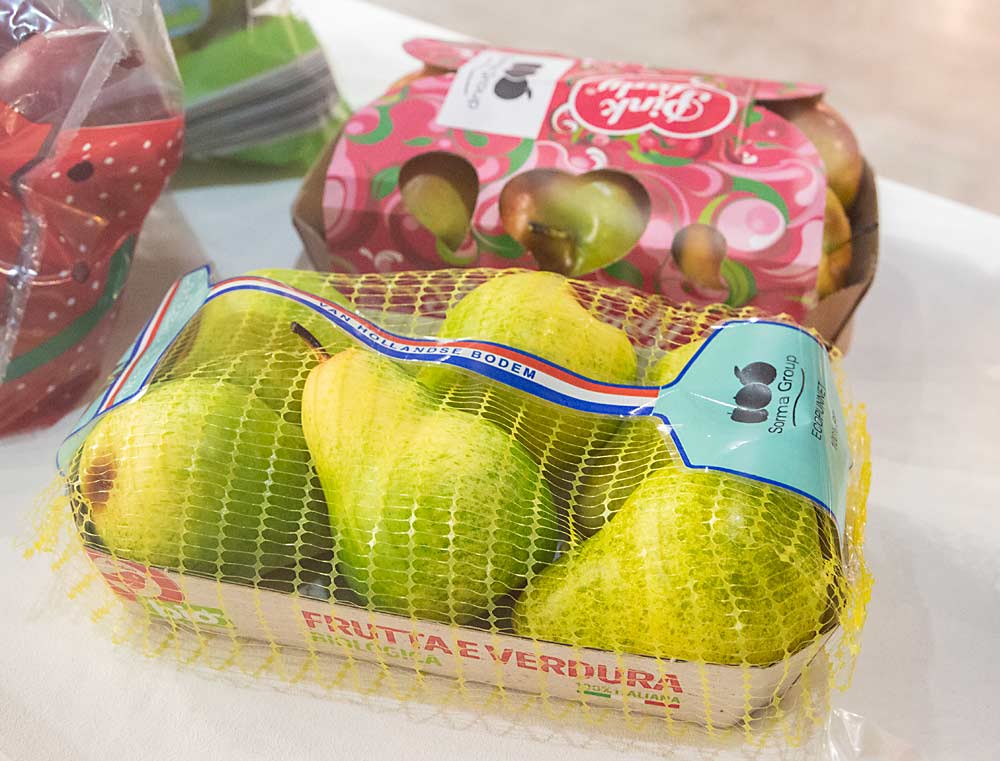
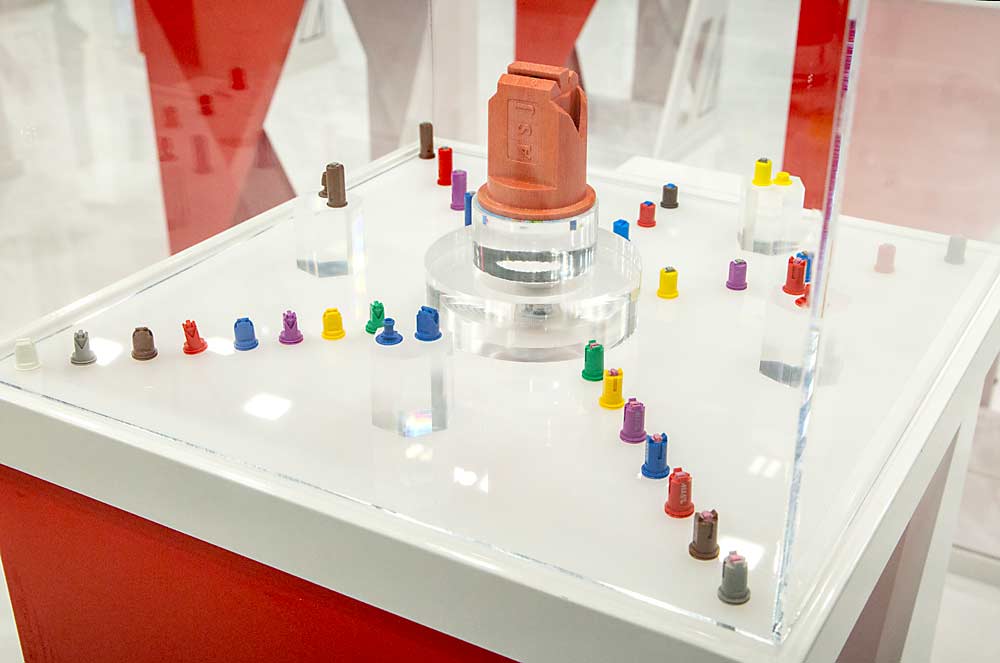
—R. Courtney

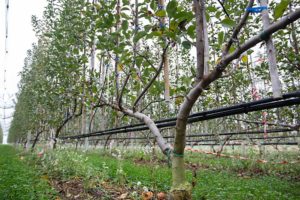
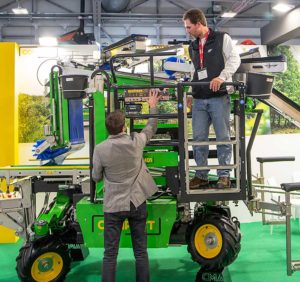





Leave A Comment